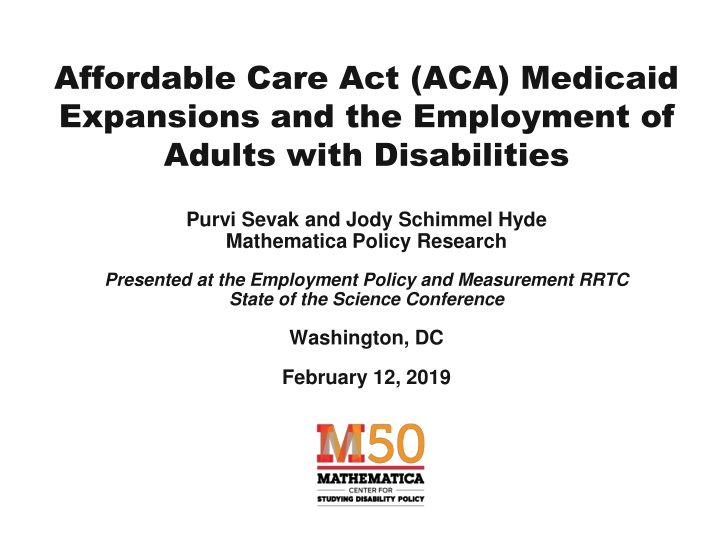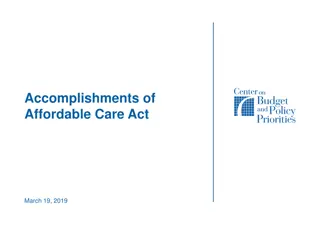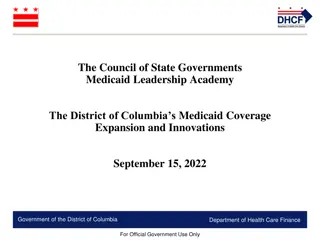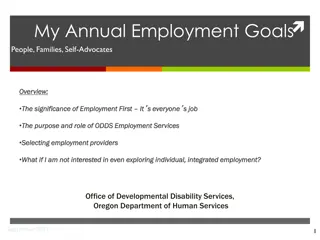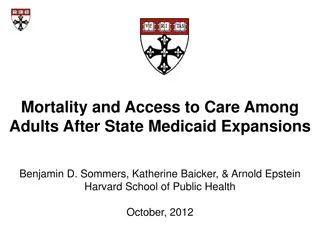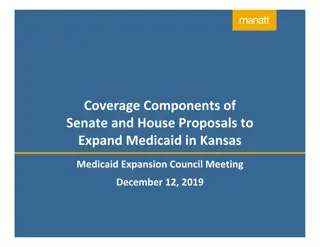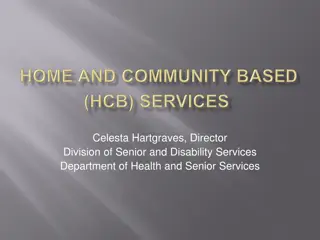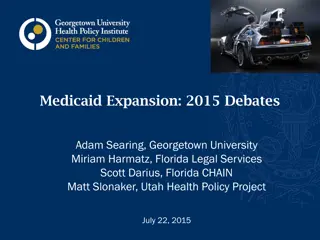Medicaid Expansion and Employment of Adults with Disabilities
The study explores the impact of Medicaid expansion on the employment of adults with disabilities, highlighting the coverage changes post-ACA and potential effects on work barriers. Findings suggest a slight increase in employment rates for individuals in expansion states. The analysis compares expansion and non-expansion states, noting disparities in poverty rates, incomes, and Medicaid participation.
Download Presentation

Please find below an Image/Link to download the presentation.
The content on the website is provided AS IS for your information and personal use only. It may not be sold, licensed, or shared on other websites without obtaining consent from the author.If you encounter any issues during the download, it is possible that the publisher has removed the file from their server.
You are allowed to download the files provided on this website for personal or commercial use, subject to the condition that they are used lawfully. All files are the property of their respective owners.
The content on the website is provided AS IS for your information and personal use only. It may not be sold, licensed, or shared on other websites without obtaining consent from the author.
E N D
Presentation Transcript
Affordable Care Act (ACA) Medicaid Expansions and the Employment of Adults with Disabilities Purvi Sevak and Jody Schimmel Hyde Mathematica Policy Research Presented at the Employment Policy and Measurement RRTC State of the Science Conference Washington, DC February 12, 2019
Availability of Medicaid to Adults with Disabilities Pre-ACA: Limited to certain groups Supplemental Security Income (SSI) Medically needy Post-ACA: Starting in 2014, states can offer Medicaid to those with incomes up to 138% of the federal poverty level As of today, 37 states have adopted the expansion
How Medicaid Expansion Might Affect the Employment of Adults with Disabilities Offers readily available coverage to the working poor Newly available coverage could: Help some people work if new coverage reduced barriers to work Mean fewer people work if new coverage allows them to leave jobs they were keeping for the insurance coverage
Literature Documents Little Effect on Employment Across the full labor force, no significant effects on: Employment rate Labor force participation Job transitions Hours worked Hall et al. (2018): Slight increase in the employment rates for people with disabilities in expansion states relative to rates in non-expansion states
How to Assess the Impact of Expanding Medicaid Natural experiment All states could have expanded, but not all did Compare states that expanded Medicaid to states that did not Assumes that expansion and non-expansion states are the same, except for the policy change Is this a reasonable assumption?
States Medicaid Expansion Status as of 2016 Blue: Expanded Medicaid, 2014 Red: Did not expand Medicaid White: Expanded Medicaid, 2015- 2016, and MA
Expansion States Differ From Non- Expansion States Pre-ACA, relative to non-expansion states, Medicaid expansion states had: Lower poverty rates, higher average incomes Higher population density Higher share with Medicaid, lower share uninsured Slightly higher employment rate for people with disabilities Slightly higher unemployment rate overall
Our Study Designs Innovation Comparison sample that closely resembled expansion states pre-ACA Used the 2010 2017 American Community Survey Used statistical tools to identify geographic areas in non-expansion states similar to geographic areas in expansion states Census Public Use Microdata Areas (PUMAs)
Comparing PUMAs in Expansion and Non-Expansion States Overall unemployment rates (%), 2010-2013 14 14 12 12 10 10 8 8 6 6 4 4 2 2 0 0 2010 2011 2012 2013 2010 2011 2012 2013 PUMAs in expansion states PUMAs in non-expansion states Expansion states Non-expansion states Source: Authors calculations using PUMA-level statistics derived from the 2010 2013 American Community Survey. Note: Expansion states include those that expanded Medicaid in 2014; non-expansion states include those that had not expanded Medicaid by 2018.
Assessing the Quality of the Comparison Group Percent of working age population with income <138% of the federal poverty line 33 32 31 32.5 31.5 31.3 30 30.7 29 Expansion states Non-expansion states PUMAs in expansion states PUMAs in non-expansion states Source: Authors calculations using PUMA-level statistics derived from the 2010 2013 American Community Survey. Note: Expansion states include those that expanded Medicaid in 2014; non-expansion states include those that had not expanded Medicaid by 2018.
Estimating the Impact of the Medicaid Expansion Calculate the change in the employment rate around the ACA in non-expansion PUMAs What would have been expected in absence of the policy change Make the same calculation in expansion PUMAs Multivariate analysis to control for individual characteristics and PUMA attributes
Findings: Expansion Had No Effect On Employment Employment rates among adults with disabilities rose post-ACA across all states No significant difference in expansion states No effect on any subgroups we examined, by: Gender Number of disabilities Educational attainment Age Pre-ACA state and local characteristics (Medicaid generosity, poverty rate, uninsured rate)
Discussion Possible reasons for no effect Positive effect in some states and negative in others? Employment impacts of Medicaid coverage may take longer to materialize Uncertainty about ACA s possible repeal Overall, the concern that people would stop working because they had other ways to get health insurance has not been borne out
Acknowledgements Funding for this study was provided by the Research and Training Center on Employment Policy and Measurement at the University of New Hampshire, which is funded by the National Institute for Disability, Independent Living, and Rehabilitation Research in the Administration for Community Living, U.S. Department of Health and Human Services, under cooperative agreement 9ORT5037-02-00.
Contact Information Purvi Sevak Center for Studying Disability Policy Mathematica Policy Research (609) 945-6596 psevak@mathematica-mpr.com http://www.DisabilityPolicyResearch.org
Appendix Improved balance in Pre-ACA trends between expansion states and matched comparison PUMAs Subgroup results
Comparing PUMAs in Expansion and Non- Expansion States (1) Population density, 2010 (per square meter) 11 10 9 8 7 6 10.4 5 4 7.2 3 4.1 2 2.9 1 0 Expansion states Non-expansion states PUMAs in expansion states PUMAs in non-expansion states Source: Authors calculations using PUMA-level statistics derived from the 2010 2013 American Community Survey. Note: Expansion states include those that expanded Medicaid in 2014; non-expansion states include those that had not expanded Medicaid by 2018.
Comparing PUMAs in Expansion and Non- Expansion States (2) Employment rates of adults with disabilities, 2010-2013 34.0 33.5 33.5 33.0 33.0 32.5 32.5 32.0 32.0 31.5 31.5 31.0 31.0 30.5 30.5 30.0 2010 2011 2012 2013 2010 2011 2012 2013 Expansion states Non-expansion states PUMAs in expansion states PUMAs in non-expansion states Source: Authors calculations using PUMA-level statistics derived from the 2010 2013 American Community Survey. Note: Expansion states include those that expanded Medicaid in 2014; non-expansion states include those that had not expand Medicaid by 2018.
Findings: No Effect on Employment of Adults with Disabilities Full set of expansion states Limited set of expansion states Males Females Ages 18-24 Ages 25-34 Ages 35-44 Ages 45-54 Ages 55-64 Less than high school High school graduate Some college College graduate One to three disabilities Four to six disabilities High poverty PUMA Low poverty PUMA High uninsurance PUMA Low uninsurance PUMA Medicaid 1634 -10.0% -5.0% 0.0% 5.0% 10.0% 15.0% Source: Authors calculations using PUMA-level statistics derived from the 2010 2013 American Community Survey. Note: Full set of expansion states includes 25 states and D.C. that expanded Medicaid in 2014; non-expansion states include those that did not expand Medicaid by 2018. The limited set of expansion states includes 21 states (and not D.C.) that had limited or no coverage for childless adults prior to the expansions.
